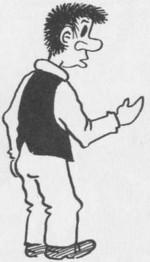
You don't have to look far to find examples of
boofhead in Australian English.
It's time for Bozo and Boofhead to go, says a Melbourne Age headline about obnoxious footballers; an ABC radio site had
Boofhead of the week, an inept home handyman. It appears in
plenty of blogs, which may give you a flavour of its usage, and Google Image
results for boofhead are also instructive.
I guess a boofhead is what Mark Twain would've called a
puddenhead, maybe with some sense of what the Brits call a
likely lad. A boofhead is a bit slow, maybe clumsy and unthinking, a likeable clot. It can be a friendly term (the inept handyman), but a boofhead can also be uncouth and boorish (the obnoxious footballers). You could say the behaviour of yer soccer hooligans is a bit
boofy.
The image of Boofhead the character (
above) is from R.B. Clark's daily comic strip.
Boofhead ran in Sydney's
Daily Mirror and in comic book reprints from 1941 until its creator's death in 1970.
It's one of those instantly recognisable Australian images, adopted by
Mambo design and by the artist Martin Sharp
for Regular Records. The Powerhouse Museum's website shows
Boofhead on a 1966 Oz Magazine cover by Martin Sharp. There's even a
statue of Boofhead in a park at
Leura in the Blue Mountains.
You could say the strip itself has an endearing boofheadedness about it, with its daft situations and its two-dimensional artwork (as far as I know, Boofhead himself is always seen in profile, Egyptian-style).

John Ryan, the Australian comic strip historian, puts it this way:
Boofhead - drawn by Bob Clark and featuring a simplistically drawn, waistcoated young man with an elongated nose sheltered by a cantilever hairstyle - was amateurish and the humour mundane. It is difficult to fathom the reasons that this strip attracted readers but there can be no disputing its popularity. (In Panel by Panel: An illustrated history of Australian comics, 1979.)
The Australian Oxford and the Macquarie dictionary both say a
boofhead is a
fool, or - picturesquely -
a person with a large head. They both suggest its source is the British word
bufflehead, defined by the Oxford Second Edition as
fool, blockhead, stupid fellow, which is certainly in
boofhead territory, and its earliest citation is from 1659.
An
Australian National Dictionary updates page has citations for
boofhead from 1941 and 1942, but doesn't mention the comic strip. I'm assuming the word predates the comic, and the comic helped popularise it, as John Ryan suggests:
Boofhead brought back into common usage the term 'boofhead' in describing a simpleton or fool.





